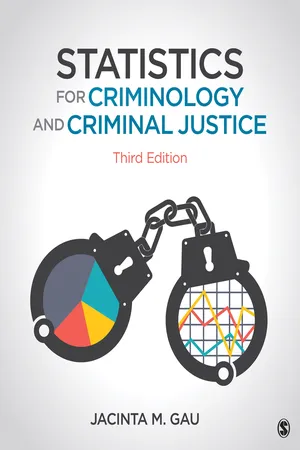
- English
- ePUB (mobile friendly)
- Available on iOS & Android
Statistics for Criminology and Criminal Justice
About this book
"…It is a great textbook for undergrads who are being exposed to statistics in the field for the first time and for Master's students who need a better grasp of the fundamentals of statistics before taking more advanced courses…"
—Calli M. Cain, University of Nebraska at Omaha
"A must-have textbook for Instructors and students alike in the fields of Criminology and Criminal Justice. The book is user-friendly."
—Bonny Mhlanga, Western Illinois University
An Introduction to Statistics in Criminology and Criminal Justice
Statistics for Criminology and Criminal Justice, Third Edition demonstrates how statistics is relevant to a student's life and future career by illustrating the logical connections between basic statistical concepts and their real-world implications in criminology and criminal justice. Written for students with a limited mathematical background, author Jacinta Gau eases student anxiety around statistics by simplifying the overarching goal of each statistical technique and providing step-by-step instructions for working through the formulas and numbers. Students use real data from the field to build a foundational knowledge of statistics, rather than merely memorizing key terms or formulas.
New to the Third Edition
- NEW Thinking Critically feature encourages students to apply the concepts from the chapter to real-life scenarios, with open-ended questions that are designed to inspire students to think about the nuances of science, statistics, and their application to criminal justice.
- Additional illustrations and examples in every chapter keep students engaged with the content and offer ample opportunities for them to practice the techniques.
- New and updated data sets from a wide range of relevant sources, such as the NCVS and UCR, BJS, LEMAS, the Census of Jails, and much more have been incorporated to give students insights into the state of criminal justice research today.
- New research on critical topics encourages students to discuss changes happening in the field such as the Census of Jails, inmate-on-staff assaults in prisons, and homicide rates.
- Practicing Statistics Whiteboard Videos, available in SAGE edge, walk students through statistical calculations to reinforce key concepts.
- Previous edition errors have been corrected by a statistician.
Give your students the SAGE edge!
SAGE edge offers a robust online environment featuring an impressive array of free tools and resources for review, study, and further exploration, keeping both instructors and students on the cutting edge of teaching and learning.
Frequently asked questions
- Essential is ideal for learners and professionals who enjoy exploring a wide range of subjects. Access the Essential Library with 800,000+ trusted titles and best-sellers across business, personal growth, and the humanities. Includes unlimited reading time and Standard Read Aloud voice.
- Complete: Perfect for advanced learners and researchers needing full, unrestricted access. Unlock 1.4M+ books across hundreds of subjects, including academic and specialized titles. The Complete Plan also includes advanced features like Premium Read Aloud and Research Assistant.
Please note we cannot support devices running on iOS 13 and Android 7 or earlier. Learn more about using the app.
Information
Table of contents
- Cover
- Half Title
- Publisher Note
- Title Page
- Copyright Page
- Brief Contents
- Detailed Contents
- Preface to the Third Edition
- Acknowledgments
- About the Author
- Part I Descriptive Statistics
- Chapter 1 Introduction to the Use of Statistics in Criminal Justice and Criminology
- Chapter 2 Types of Variables and Levels of Measurement
- Chapter 3 Organizing, Displaying, and Presenting Data
- Chapter 4 Measures of Central Tendency
- Chapter 5 Measures of Dispersion
- Part II Probability and Distributions
- Chapter 6 Probability
- Chapter 7 Population, Sample, and Sampling Distributions
- Chapter 8 Point Estimates and Confidence Intervals
- Part III Hypothesis Testing
- Chapter 9 Hypothesis Testing A Conceptual Introduction
- Chapter 10 Hypothesis Testing With Two Categorical Variables Chi-Square
- Chapter 11 Hypothesis Testing With Two Population Means or Proportions
- Chapter 12 Hypothesis Testing With Three or More Population Means Analysis of Variance
- Chapter 13 Hypothesis Testing With Two Continuous Variables Correlation
- Chapter 14 Introduction to Regression Analysis
- Appendix A. Review of Basic Mathematical Techniques
- Appendix B. Standard Normal (z) Distribution
- Appendix C. t Distribution
- Appendix D. Chi-Square (χ2) Distribution
- Appendix E. F Distribution
- Glossary
- Answers to Learning Checks
- Answers to Review Problems
- References
- Index